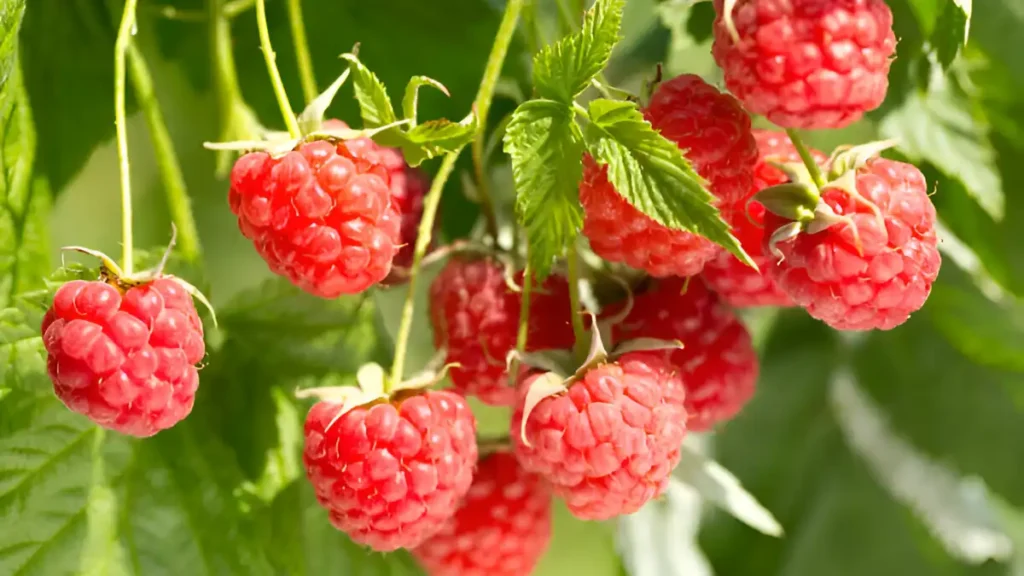Raspberries are a popular fruit due to their bright color, juicy texture, and sweet-tart flavor. Raspberries are great in jams, pies, tarts, smoothies, and drinks, in addition to being ideal for plucking and eating right off the stem. They are indigenous to North America, Europe, and Asia, and they thrive in a variety of temperatures. Here is detailed information on planting and caring for raspberries.
When to plant raspberries:
- Start with raspberry canes from a reliable nursery that is one year old. As the earth thaws and becomes workable, plant in the early spring.
- Planting in late autumn might also offer plants a head start in milder climates.
- After there is no longer a chance of frost, plant potted transplants in the spring.
Learn how to plant raspberries:
- Before planting, let the roots soak for one or two hours. Ideal soil has a pH of 5.5 to 6.5, is well-drained, and is slightly acidic. Loamy, rich soil is suitable.
- Growing raspberries requires six to eight hours of sunlight per day, so place them where they will receive this benefit.
- Create a space in the hole that allows the roots to grow. The depth of the roots should be two to three inches.
- Not placing them within 300 feet of any wild blackberry bushes is another thing to take into account while planting.
Everything about raspberry plants care:
- Watering
Water frequently, particularly in arid times. Keep the roots consistently moist without letting them get too wet. Foliage should be kept dry and disease risk should be minimized via drip watering or soaker hoses.
- Fertilizing
Fertilize raspberries twice a year in the first year of planting, according to recommended care. You may then fertilize your raspberry plants every year as they grow. Each 100 feet of row requires two to three pounds of 10-10-10 fertilizer.
- Mulching
Mulching helps manage soil temperature, suppresses weeds, and retains moisture. Make sure the land is kept clear of weeds when cultivating raspberries. Don’t forget to give the shrubs regular watering. Utilizing a mulch made of straw can aid in controlling weed growth.
- Pruning of raspberry plants
The type of raspberry you’re cultivating will determine how you prune it. Trimming summer raspberries is recommended twice a year. Pruning should be done either selectively for two crops or completely for an autumn crop in late winter or early spring.
- Propagating
As raspberries are susceptible to numerous diseases and viruses as they mature, reproduce only from recently purchased, certified virus-free plants. This will ensure that the new plants have less vitality and crop potential.
- Treatment of diseases and pests
During June through August, be aware of Japanese beetles and spider mites. Particularly, Japanese beetles love strawberries. In winter, rabbits enjoy munching on the canes. Rabbit damage can be avoided with the use of a chicken wire fence.
- Seasonal care tips
In colder climates, cover plants with a layer of mulch or straw to insulate their roots. To get your raspberries ready for the upcoming growth season, prune them according to the kind you have.
- Harvesting raspberries
When your berries are vibrantly colored, they are ripe enough to eat. Gather raspberries by carefully pulling the fruit off. Once you find the ideal sweetness, you can begin sampling them every day. Before the birds do, make sure you gather your raspberries.
Conclusion:
Raspberries are renowned for their sweet-tart flavor and vivid color. They are a very nutritious and adaptable fruit. They are a great complement to a balanced diet because of their abundance of vitamins, minerals, antioxidants, and dietary fiber. Antioxidants such as vitamin C and quercetin, which are abundant in raspberries, may offer protection against some chronic diseases. Planting raspberries can be successful if you adhere to the above criteria.
Certainly! If you’d like to learn more, please consider following our WhatsApp Channel: Harvest Gardening
A frequently asked questions:
Q1. Can dogs have raspberries?
A1. Sure, when given in moderation, dogs can eat raspberries. Dogs may benefit from the antioxidants, fiber, and vitamins found in raspberries.
Q2. How to grow raspberries indoors?
A2. When growing raspberries indoors, it is recommended to use fertile soil, expose the plants to direct sunlight for at least 6 to 8 hours each day and water them whenever it feels like the top inch of soil is dry.
Q3. How long do raspberry plants live?
A3. Though their productivity begins to diminish after around 5-8 years, raspberry plants normally live for about 10-15 years. Their productive lifespan can be increased with proper upkeep and care.
Q4. How many types of raspberries are there?
A4. There are more than 200 species of raspberries, including well-known kinds like golden, black, purple, and red. The color, flavor, and growth traits of these types vary.

